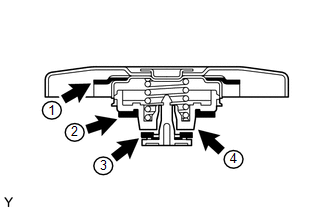Toyota Venza: On-vehicle Inspection
ON-VEHICLE INSPECTION
PROCEDURE
1. CHECK RADIATOR CAP SUB-ASSEMBLY
(a) Measure the valve opening pressure.

(1) If there are water stains or foreign matter on rubber packings 1, 2 or 3, clean the part(s) with water and finger scouring.
(2) Check that rubber packings 1, 2 and 3 are not deformed, cracked or swollen.
(3) Check that 3 and 4 are not stuck together.
(4) Apply engine coolant to rubber packings 2 and 3 before using the radiator cap tester.
|
(5) When using the cap tester, tilt it to 30° or more above level. |
|
(6) Pump the cap tester several times, and check the maximum pressure*.
Pump speed:
1 pump per second
*: Even if the cap cannot maintain the maximum pressure, it is not a defect.
Judgment Criterion:
|
Item |
Specified Condition |
|---|---|
|
Standard value (for brand-new cap) |
94 to 122 kPa (1.0 to 1.2 kgf/cm2, 13.6 to 17 psi) |
|
Minimum standard value (for used cap) |
79 kPa (0.8 kgf/cm2, 11.4 psi) |
If the measured maximum pressure is less than the minimum standard value, replace the radiator cap sub-assembly.
 Components
Components
COMPONENTS
ILLUSTRATION
ILLUSTRATION
ILLUSTRATION
...
 Installation
Installation
INSTALLATION
PROCEDURE
1. INSTALL RADIATOR ASSEMBLY
(a) Install the fan assembly with motor to the radiator with the 2 guides
at the bottom and 3 snap fits on the top.
Text in Ill ...
Other materials about Toyota Venza:
List of storage features
1. Bottle holders
2. Door pockets
3. Auxiliary boxes
4. Overhead console
5. Console boxes
6. Glove box
7. Cup holders
CAUTION
- Items that should not be left in the storage spaces
Do not leave glasses, lighters or spray cans in the storage spa ...
Removal
REMOVAL
PROCEDURE
1. REMOVE ENGINE OIL LEVEL DIPSTICK GUIDE
(a) Remove the engine oil level dipstick.
(b) Remove the bolt and engine oil level dipstick guide.
(c) Remove the O-ring from the engine ...
ECM / PCM Processor (P0606)
MONITOR DESCRIPTION
The ECM continuously monitors its main and sub CPUs. This self-check ensures
that the ECM is functioning properly. If outputs from the CPUs are different and
deviate from the standard, the ECM illuminates the MIL and stores the DTC imm ...
0.1439

